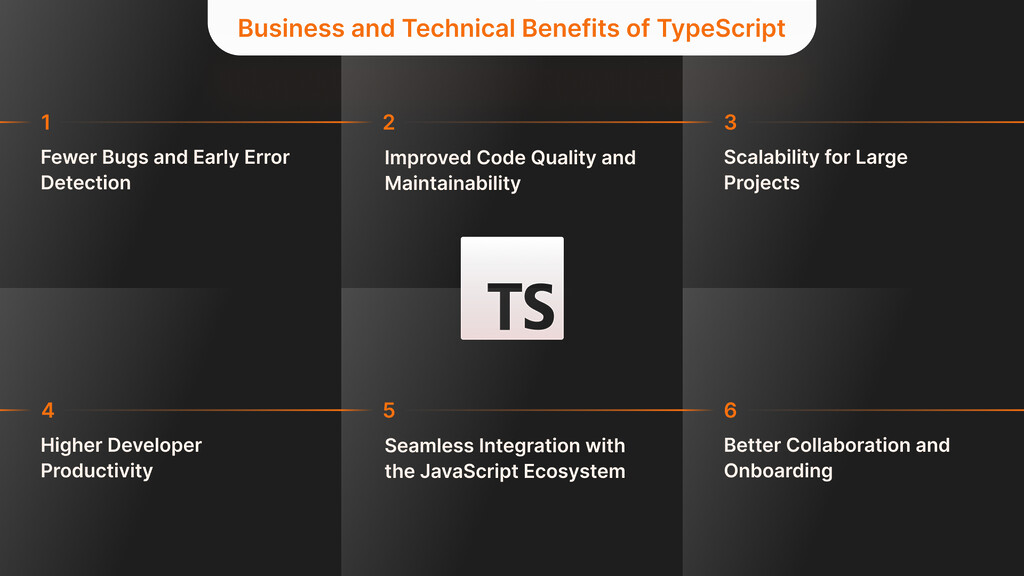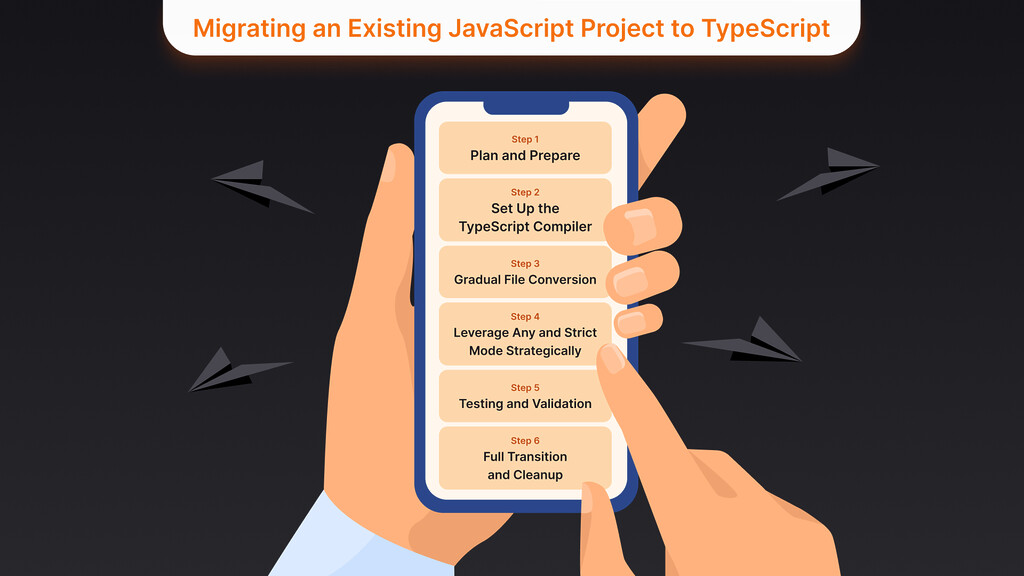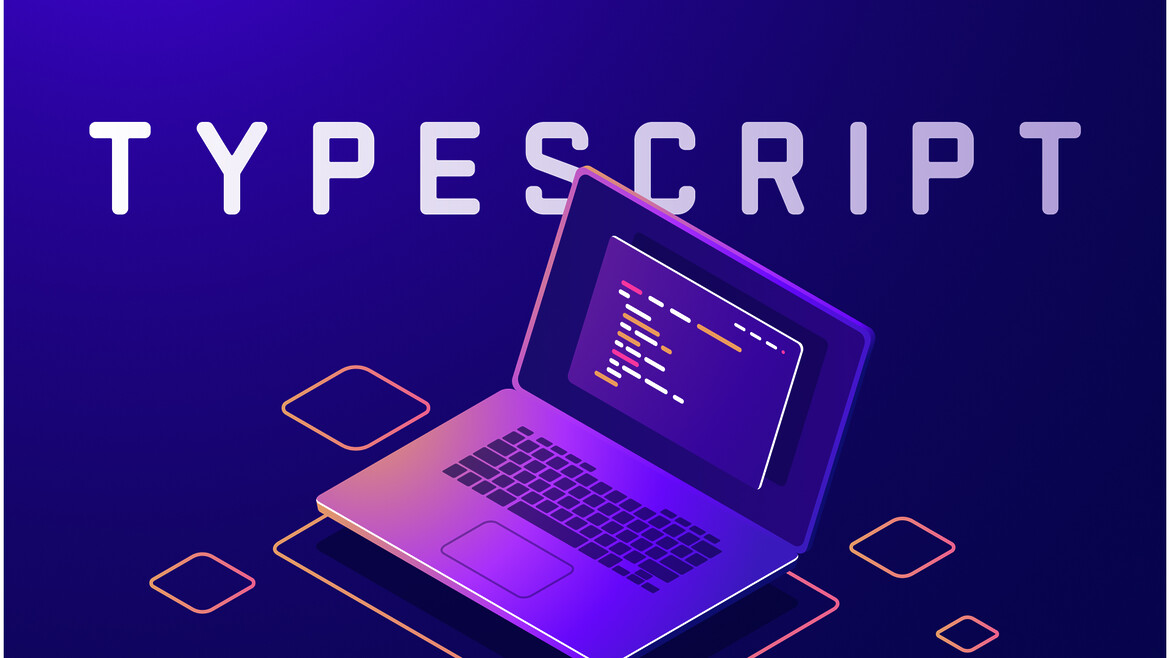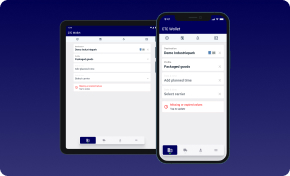TypeScript is a vital element of contemporary web development because it provides essential characteristics that benefit both startup and enterprise development projects. This in-depth guide explains TypeScript, its business advantages, and technical benefits, and includes information on project integration. The article presents usable guidance about TypeScript adoption, which includes details on switching over from existing code and insights into working with TypeScript development service providers. The conclusion of this guide will consist of advice to help you select a TypeScript development company that will guarantee your project’s success.
What Is TypeScript? (A Non-Jargon Introduction)
The supercharged version of JavaScript exists as TypeScript. Microsoft developed this open-source programming language as an extension of JavaScript that adds static typing and modern features. Through TypeScript, developers can establish variable and function types using plain language syntax by defining numbers, strings, and custom objects. The major advantage of TypeScript becomes clear when developers learn that it allows code analysis for errors before execution. The framework transforms program code into standard JavaScript, which servers using Node.js alongside browsers can execute without restrictions.
TypeScript functions as an extension of JavaScript because all JavaScript code that works in TypeScript also works in JavaScript. Developers who choose TypeScript can implement it step by step without requiring complete code replacement. The TypeScript framework adds type verification and other development tools to JavaScript, making it possible for developers to detect errors before deployment and improve code structure. The compiler in TypeScript detects when developers combine strings with numbers, which prompts a warning during development time before errors occur in production environments.
Decision-makers maintain complete control over their development process since adopting TypeScript does not require them to stop using JavaScript or restrict their available options. The code from TypeScript transforms into ordinary JavaScript, which maintains complete compatibility with any current platform and library. Major tech companies fully support TypeScript because Google selected it as Angular’s framework language, and numerous large applications use it in their systems. The popularity of TypeScript has surged rapidly during the past few years. Hence, developers now frequently choose it among their preferred languages, while approximately 65% of JavaScript developers incorporate TypeScript somehow into their work. The large-scale adoption of TypeScript demonstrates its position as a reliable technology for developing contemporary software solutions.
Business and Technical Benefits of TypeScript

Startups, along with CTOs and product managers, should pay attention to TypeScript because it provides several concrete advantages for software projects. These advantages create opportunities for business growth.
Fewer Bugs and Early Error Detection
The biggest advantage of TypeScript involves detecting errors before coding reaches the development stage. Static typing alongside compile-time checks helps the system identify multiple JavaScript mistakes before program execution. According to research findings, TypeScript enables the detection of 15% of common bugs during compile time. This represents a substantial amount of problems identified early in development. TypeScript protects your application from runtime crashes and production glitches by stopping specific errors from entering the development process. A reduction in bugs lowers both debugging costs and QA expenses while simultaneously delivering better user reliability in your product.
Improved Code Quality and Maintainability
The type system of TypeScript, along with interfaces and classes, creates code structures that enforce better code organization. The structure implemented by TypeScript results in code that becomes both easy to read and automatically documents itself. Development teams must define all data patterns explicitly to create code that developers and users can understand more easily. TypeScript ensures that function input objects contain the required fields because it checks for their presence before execution. Due to TypeScript, everything retains its original form because variables intended to be strings remain as strings without changing into booleans or other types at any point. The system’s ability to predict data types enables easier maintenance operations, especially during project expansion. Reading the defined types in the code allows developers who follow or work with the same project to understand what the original developer intended to achieve. Clear variable definitions in large and distributed teams help prevent misunderstandings through miscommunication. The structured methods of TypeScript produce maintainable and robust codebases, which leads to significant improvements in product quality over time.
Scalability for Large Projects
The growth of your application and engineering team leads to difficulties when handling an expansive JavaScript codebase. The developers created TypeScript specifically to work well with extensive development projects. Combining TypeScript language features with its compiler system enables the smooth organization of complex code structures. The modular organization of code through ES modules or namespaces exists in TypeScript, while the tool flags inconsistencies that may appear within large-scale projects. The static typing system provides developers with safety measures during refactoring and feature addition because it identifies all sections requiring updates. Teams maintain freedom to develop their codebase because they do not face risks of complete breakdowns. Organizations that select TypeScript experience increased code dependability along with better refactoring capabilities that help them introduce new features and welcome new developers without triggering critical failures. TypeScript helps companies develop their software faster while enabling them to expand their applications with minimal operational issues.
Higher Developer Productivity
Developer efficiency receives major enhancements through the tooling support, which comes with TypeScript. Modern code editors based on VS Code and WebStorm leverage TypeScript type details to generate advanced IntelliSense toolsets, including autocompletion and real-time error detection alongside intelligent navigation tools and refactoring functions. Users receive live feedback from the editor while typing because it proposes methods while simultaneously marking errors and providing automatic repair options for selected issues. The development process becomes shorter because engineers must spend less time identifying and fixing simple errors and looking for documentation. TypeScript offers improved IDE functionality with autocompletion, which leads to a quantifiable performance improvement in development work. The development process speeds up while developers gain increased assurance due to team collaboration. A business receives quicker market delivery of new features and potential cost reductions because its developers operate at peak efficiency.
Web Development for a Strong Digital Foundation
Build a Robust Online Platform with Our Expertise
Discover Web DevelopmentSeamless Integration with the JavaScript Ecosystem
Using TypeScript results in no loss of access to the extensive JavaScript library network. TypeScript maintains entire JavaScript compatibility, which allows teams to leverage existing JavaScript libraries and frameworks. The DefinitelyTyped repository contains thousands of type definitions for popular JavaScript libraries, which enable TypeScript to understand and verify the usage of libraries such as jQuery, Lodash, and moment.js. Your organization can keep working with existing tools such as React, Node.js, Angular, Vue, D3, etc., while TypeScript provides additional protection through its implementation. Microsoft actively maintains TypeScript to align with JavaScript standards, which leads the language to support upcoming browser features before broad public adoption. Forward compatibility enables your developers to create modern code that maintains future-proof protection. The benefits that TypeScript provides exist independently of any need to change your existing systems because it extends JavaScript instead of substituting it.
Better Collaboration and Onboarding
CTOs who manage teams will experience improved collaboration as one of the unnoticed TypeScript advantages. The explicit structure in TypeScript code defines data flow understanding by showing clear interfaces along with types to every team member. Each team member can develop different code sections independently since the compiler enforces component contracts to prevent conflicts. Team members who join the project better understand the system design through the well-typed code, which functions as internal documentation. The data modeling requirements of TypeScript force developers to invest effort in interface planning, which produces beneficial design discussions that produce superior software quality. A smoother development process will result from these factors working together, thus delivering predictable deliverables alongside efficient teamwork for business needs.
Through combining early error detection and structured code development with strong development tools, TypeScript produces robust software that scales well. A startup could prevent serious launch-time bugs by employing TypeScript before customers post negative reviews. By choosing TypeScript, an enterprise achieves reduced maintenance challenges along with the capacity to develop its product through additional features. TypeScript has gained popularity among development teams because it provides appropriate protection alongside developer freedom, delivering technical mastery, project speed, and responsiveness.
Using TypeScript in Web Application Development
TypeScript offers universal adaptability by integrating seamlessly into every development project based on the web. A single-page application for consumers or an enterprise system demands TypeScript as a fundamental tech stack component. The standard practice for using TypeScript in contemporary web application development includes the following steps:
Front-End Development
Client applications benefit greatly from using TypeScript when developing comprehensive web applications. TypeScript functions seamlessly with numerous popular front-end frameworks and libraries when used by default. All development for Angular relies exclusively on TypeScript, while projects created with Angular CLI specify TypeScript as their default configuration. The TypeScript framework works with React and Vue.js through TSX components for React and single-file components in Vue.js. Type safety enables developers to build all parts of their UI components and state logic together with their program logic. Protection against typical UI bugs becomes possible when developers prevent sending improper data to individual components, thus improving the robustness of the front-end code. Through the support of JSX and full web standards, TypeScript enables developers to build responsive interfaces that function in all browsers since the transpiler converts every project into plain JavaScript that browsers understand. The TypeScript approach to front-end development scales through interfaces for component props, strict types for state exploration, and comprehensive autocompletion features during UI development.
Check out more on Key React Statistics: A Comprehensive Analysis.
Back-End Development
Typescript maintains equal effectiveness for server work when developers implement it with Node.js (or Deno). More server-side projects now use TypeScript because developers benefit from the same positive aspects of decreased runtime errors and enhanced code maintainability in their backend development. Typescript enables developers to build their API servers, microservices, and serverless functions. The server frameworks Express, NestJS, and AdonisJS include complete TypeScript integration. Your backend project benefits from integrating TypeScript, as it enforces data model consistency throughout your business rules. Users should define a User type or interface in their TypeScript code, which ensures consistent data protection across the entire backend system while different modules maintain error-free communication. Node.js operates as fast as JavaScript code because it executes compiled TypeScript output. The runtime performance remains unaffected by this process. Every setting that executes JavaScript can also execute code compiled from TypeScript, eliminating the need for special servers or infrastructure. The added benefit of using TypeScript for your front-end is type sharing with your server, which lets you maintain consistency between all stack components. Full-stack TypeScript development leads to better performance by integrating all project elements, which reduces gaps between front-end and back-end data operations.
For practical use with AWS, read Building Serverless Microservices with AWS CDK.
Build Tools and Workflow
Including TypeScript in web projects introduces a compilation step in your development process, yet modern development tools simplify this transition. The project root typically requires a developer to establish a TypeScript configuration file called tsconfig.json, which informs the TypeScript compiler about the code compilation process. The compilation can operate alongside Webpack, Parcel, and Vite build systems and with Gulp task runners. Different starter kits and frameworks incorporate built-in TypeScript support for developers. Whenever you start a React app with Create React App and Next.js using TypeScript, you can enable the language with a straightforward command that automatically handles all configuration tasks. During development, developers typically enable live compilation with the TypeScript compiler to achieve file save-triggered compilation and serving. The edit-refresh development cycle works at its typical speed for developers using this approach. The development speed remains unaffected by selecting TypeScript with Webpack hot reload or Vite’s lightning-fast server. The time dedicated to error detection alongside editor recommendations proves more beneficial than the time required to perform compilations.
Testing and QA
TypeScript also complements testing efforts. TypeScript permits early identification of errors so your QA team can pursue advanced testing like functional and user experience checks instead of spending time on elementary regressions. TypeScript intercepts developers when they try to call functions with incorrect parameter types, thus preventing unit test failures or severe production bugs. While TypeScript enhances development, it stands separate from testing operations. You will maintain your development of unit tests alongside integration tests, etc, but these tests can operate under the strengthened base of TypeScript. The testing tools and frameworks, Jest, Cypress, and Mocha, provide support for TypeScript through their ability to let developers write tests in TypeScript. The type-checking functionality for test code eliminates errors that result in unstable test outcomes. Using TypeScript during development helps establish a “correct by construction” methodology through which several errors are identified and fixed before entering the testing phase.
Custom Software Development for a Competitive Edge
Build Unique Software Solutions with Our Expertise
Explore Custom SoftwareWeb application development with TypeScript involves writing code through .ts files alongside .tsx files for React instead of traditional JavaScript .js files. The development team will use standard web technologies in their work, as before, yet they will benefit from TypeScript’s additional safety features. The development looks for errors instantaneously, which would typically require daily debugging in pure JavaScript. The smooth integration between TypeScript and web technologies has made it a standard for serious application development, which results in faster growth, reliable deployments, and easy web application maintenance.
Migrating an Existing JavaScript Project to TypeScript

A JavaScript codebase owner who wants to introduce TypeScript must understand the process for integrating it while protecting their current application infrastructure. TypeScript delivers a solution that enables teams to adopt it progressively. The migration process allows you to transition an existing project through individual steps rather than performing a complete, risky transformation. A wide range of teams have implemented successful transitions of extensive JavaScript projects to TypeScript through gradual development methods.
The following points describe the steps for migrating from JavaScript to TypeScript:
Step 1: Plan and Prepare
The first step should be to examine your project alongside your libraries. Verify that each npm package you use provides TypeScript type definitions that are available either as built-in features or through the DefinitelyTyped community. Fundamental TypeScript knowledge or training should be provided to your development team before starting. A standard coding framework, together with strict mode selection and type management decisions, falls under the preparation steps.
Step 2: Set Up the TypeScript Compiler
Your task does not require complete conversion at the beginning. To begin the technical conversion process, add a tsconfig.json configuration file to your project while installing the TypeScript compiler. The coexistence of TypeScript with JavaScript files becomes possible during a migration process. The config allows you to activate the allowJs feature for compiler acceptance of plain .js files. At the same time, checkJs enables TypeScript type-checking of existing JS with JSDoc comments or type inference capabilities. Adding TypeScript oversight to your project becomes possible by allowing this configuration, which requires no code changes. You can start by turning on noEmit to analyze files without writing them during the dry run phase.
Step 3: Gradual File Conversion
You can begin converting JavaScript files to TypeScript one at a time after executing the necessary preparations. Organizations typically start by working on the most essential modules or basic utility functions to establish a positive workflow momentum. The preliminary step consists of converting .js file extensions into.ts extensions, while .tsx extensions replace .jsx files when dealing with React code. The conversion of a file to .ts status will result in TypeScript errors appearing for any code that violates type consistency. Newly converted files may present numerous warnings, but this is precisely the purpose TypeScript serves to identify. The incremental correction of issues happens through type annotation additions or by adjusting the code base. The migration allows you to specify the return type of any implicit function and add appropriate annotations. The conversion process occurs one file at a time instead of requiring all fixes to happen simultaneously. The application can continue execution with JavaScript and TypeScript files since the TypeScript compiler produces JavaScript from converted files, which operate alongside the unconverted JavaScript files.
Step 4: Leverage Any and Strict Mode Strategically
The strictness of TypeScript applies to migration according to your decisions. At first, it makes sense to enable any type (which disables type-checking for variables) in specific areas to establish operational functionality. You should expect this behavior during initial implementation because the codebase’s typing quality should improve over time. TypeScript provides gradual typing capabilities that let you begin with a few type annotations while adding more annotations as you progress. The complete advantages of TypeScript require enabling strict compiler options (such as noImplicitAny and strictNullChecks) only after sufficient code annotation. The main strategy involves continuous improvement through adding types, followed by error resolution, stricter rules enforcement, and repeating the process.
Step 5: Testing and Validation
You should execute your test suite or perform basic application testing after finishing each module or converting each batch of files. The primary purpose is to verify that TypeScript modifications have not caused any backward steps in application functionality. After compiling the code and successfully handling types, the system should operate identically to the previous version (TypeScript only modifies development-time features while runtime stays unchanged). The successful completion of a migration requires testing because tests demonstrate that the TypeScript conversion has not affected program behavior. More code written in TypeScript leads to improved code understandability and certain types of bugs becoming impossible to occur.
Step 6: Full Transition and Cleanup
Typical .js files should be considered technical debt after reaching a majority of TypeScript code integration. The conversion of those last pieces will occur once you remove the allowJs flag. You should eliminate or reduce any types whenever possible to achieve maximum typed codebase excellence at this point. The conversion period enables teams to enhance their project structure and implement modern TypeScript/JavaScript elements by substituting outdated JavaScript patterns for contemporary ES6+ and TypeScript standards. The project evolves into a complete TypeScript application without stopping development through the process, which runs alongside normal feature creation.
The success of this process requires either an experienced team member with TypeScript expertise or professional development assistance from a migration specialist. The migration process benefits from experienced team members who can predict challenging sections (such as handling dynamic code or library definitions) to define proper practices.
Why does gradual migration work?
The complete subset relationship between JavaScript and TypeScript enables developers to bring any JavaScript files into their TypeScript project. The initial file mixing process allows developers to reconstruct project parts one by one. TypeScript specifically accommodates existing JavaScript projects through its integration features, which enable teams to transition their codebases piece by piece. The design philosophy allows businesses to maintain user updates during product development while they enhance their code quality and maintainability through TypeScript.
Digital Transformation for Competitive Advantage
Empowering Your Business with Tailored Digital Solutions
Explore Digital TransformationThe JS codebase functions as a town with disorganized streets. Adopting TypeScript involves installing traffic control systems to improve navigation and safety in existing codebases. You will receive major benefits after migration because your project uses all the TypeScript advantages we covered (bug reduction and easier maintenance). Teams indicate developers become perplexed about how they operated before TypeScript introduced its protective features following migration.
The path to successfully migrating to TypeScript from JavaScript involves well-established principles for breaking down projects into small stages, which allows the transformation of even large JavaScript applications. Your product achieves a more substantial base supporting its upcoming development work. Your strategic process investment will bring future advantages through better code quality and simplified maintenance.
Steps to Start with TypeScript in Your Project
Leaders need to understand the steps to begin using TypeScript since they believe it delivers value to their projects. Businesses and teams should follow these steps to initiate their adoption of TypeScript:
Evaluate Project Needs and Benefits
Your organization should identify the areas where TypeScript adoption will create the most significant impact within your project scope. Starting with TypeScript at the beginning of web application development or feature implementation provides the best opportunity for new projects. To determine if TypeScript would benefit your existing product, you should identify its main issues, including undefined errors during production and difficulties among new team members to understand the codebase. TypeScript demonstrates capabilities that match most of your system’s pain areas, which include protection against undefined errors and automatic documentation generation. Applying this analysis will facilitate the creation of a business case and team member agreement. The study determines if the entire codebase needs migration to TypeScript or if developers should begin using TypeScript only for new development modules.
Secure Management and Team Buy-In
Any new technology adoption alongside substantial development process changes needs approval from key stakeholders. Product managers and CTOs need to explain to their teams the reasons behind TypeScript implementation by presenting data that demonstrates reduced bugs and faster development times. Investing in better code quality through TypeScript will lead to fewer urgent hotfixes at night and better development of new features. The development team should accept TypeScript as a beneficial tool that enhances their work instead of a heavy obligation. It is crucial to schedule time for developers to learn TypeScript, although they may be naturally drawn to it because of its growing popularity. The team needs brief training sessions about TypeScript fundamentals through workshops or pair programming to learn this language effectively.
Start with a Pilot or Critical Module
Initiate the product deployment by starting with a pilot project or select a single application module instead of turning on everything at once. Project initiation includes using TypeScript to create the new system’s first framework. When dealing with a current application development, consider transforming a small part of the program into TypeScript either through rewriting a component or creating a new section that functions independently from the original system base. The team gains practical experience through this process while directly observing the advantages in a limited-scale format. The pilot needs to be sized to show TypeScript benefits (such as complex data handling or critical program logic), yet it should avoid overwhelming developers. A retrospective evaluation should be conducted to determine if TypeScript enabled the detection of issues while the project was finished. How was the developer experience? The achievement of early wins will build up momentum, leading people to embrace broader adoption.
Put the Right Tooling and Infrastructure in Place
The development platform for TypeScript needs a proper setup before starting the implementation. Your build pipeline needs an update to include TypeScript compilation, provided that you use a framework that would handle most of this automatically. Developers need appropriate editing tools that integrate well with TypeScript (VS Code presents stellar integration features). Introducing ESLint with TypeScript rules will let developers maintain a consistent code style while detecting potential issues that might occur from undefined cases. Your source control and continuous integration systems need configuration to run the TypeScript compiler, which detects type errors during pull request vetting. TypeScript compiler errors should be handled similarly to failed unit tests and lint issues in your development process. When you integrate it with CI, you prevent code without type-checking from reaching your main branch. Early establishment of TypeScript requirements as part of the project’s definition of done will establish the standard.
Gradual Rollout and Iteration
The following stages of adoption should be planned following the completion of the pilot or module. The phase-based conversion of additional codebase sections will follow the instructions in the migration section. You should develop new features in TypeScript for new projects, while planning to refactor your previous codebase when you work on it. Follow team feedback to modify your practices. You may choose to relax specific compiler options that slow down your team during that period. When everything runs smoothly, you should apply stricter typing to increase your project’s safety. Create official documentation that specifies rules for TypeScript implementation across the team, including use cases for any and definition structuring standards. Incrementally, you will increase TypeScript coverage. The team should present examples of how TypeScript reduced bugs during production and minimized integration issues for Feature X, among other achievements. Implementing these guidelines shows the worth of the initiative to your team members.
Leverage Expert Help if Needed
Small teams or organizations can benefit from working with external TypeScript development services to initiate their project. Several software development firms specialize in TypeScript development to provide consulting or partial migration and development services to your team. Expert involvement helps reduce the learning time frame while maintaining optimal practices during early project development. TypeScript-experienced developers can establish the project layout and configuration settings and transform a limited number of sample code modules that internal staff members can use for reference. The mentoring approach provides very efficient results when applied. The following section will address TypeScript development company partnerships, yet the main point remains to seek outside help when it speeds up your transition or provides necessary expertise. The main objective remains to achieve both a seamless transition and maximum beneficial results.
A systematic implementation of TypeScript starts with following this step-based approach. Implementing TypeScript does not require a complete transformation since you can build from small beginnings while expanding usage after seeing tangible improvements. An organized implementation plan combined with team backing allows TypeScript adoption without major operational problems while delivering lasting positive effects. The transition to TypeScript has benefited numerous organizations, resulting in superior code quality and a content development team that benefits from modern tools and TypeScript’s reliability features.
For infrastructure setup and automation strategies, read Infrastructure as Code: A Comprehensive Guide.
What to Expect from a TypeScript Development Company
You need to define the value and services that partnering with a TypeScript development firm for your project will deliver when you decide to outsource parts of your work. TypeScript development companies provide their clients with experience in application development utilizing TypeScript technology along with its supporting frameworks and tools. Such a company offers its clients the following essential benefits:
Expert Guidance and Planning
A quality TypeScript development company starts by comprehending your project’s mission alongside its present architecture and existing difficulties. The company will execute a code audit to analyze your JavaScript base before creating migration guidelines when you bring existing projects. During new project development, they assist in making technology selection choices ranging from Angular-React decision to Node.js framework selection. Their past project experience allows them to suggest standard operations before project initiation. A well-defined action plan with specific timeframes, achievement measures, and procedures for TypeScript implementation must be presented. The essential planning stage helps all team members maintain a unified approach.
Top-Tier TypeScript Talent
The primary benefit of working with a TypeScript development company is obtaining developers who already excel at TypeScript development while also understanding both front-end and back-end programming. The developers working on TypeScript projects must demonstrate a complete understanding of its specific features and standard framework applications. A web application development typically requires TypeScript specialists to create front-end sections with React/Angular and Node.js expertise for the back-end components. The team possesses sufficient knowledge to apply TypeScript features effectively to develop tidy and efficient code. The quality-oriented development firms boast about their skilled personnel by announcing their possession of “top 1%” developers and similar professionals. According to the marketing statements, the developers assigned to your project should demonstrate extensive experience working with TypeScript and through their documented projects. The developers’ deep expertise leads to early production of reliable code that combines TypeScript features with their personal experience to detect problems before deployment. The combination of development speed and reliable deliverable stability results from experienced developers using TypeScript.
Full Development Lifecycle Support
The whole software development process falls under the scope of TypeScript development services. The organization can manage all stages of software development, from design to implementation to testing, before deployment. The company will implement application code using TypeScript while establishing the build and CI/CD pipeline infrastructure and developing test cases, which might also utilize TypeScript. The development process features Agile methodologies so that you will experience repetitive development cycles with sprint-based work, followed by demonstration sessions and ongoing project status feedback. The development team must be skilled at maintaining project management tools and communication platforms such as Jira for tasks, Slack or email for communications, and other related tools. Implementing TypeScript within a project brings attention to code quality, which leads to a focus on static analysis and code review activities. The development team performs peer-based code reviews of pull requests to verify that TypeScript code maintains proper quality standards while ensuring adequate usage of types to prevent loosely-typed errors. The company should complete its project by supplying the raw code with documentation, which may include README files, generated interface documentation, and codebase style guidelines.
Smooth Collaboration and Knowledge Transfer
Professionals who work for development companies ensure simple collaboration practices. The company allows you to add TypeScript engineers as part of your staff (these engineers work remotely with your internal team). When your team operates with a nearshore firm during overlapping hours, they can resolve issues quickly through real-time communication. The development company will establish consistent meeting sessions to achieve synchronization. Excellent development teams stress the importance of soft skills when their developers need to present complex information easily while providing business-oriented solutions and actively listening to client needs. The development partner needs to accept your questions about changes and show flexibility in their response. Knowledge transfer should be a priority since you plan to shift internal staff onto the project eventually. External developers must prepare the in-house team to handle the codebase. The team should conduct walkthroughs and training sessions, which explain both the implemented features and the TypeScript implementation in the project.
Focus on Your Business Needs
Resolving business problems remains the primary goal, although TypeScript represents a technological approach that a reputable development company always considers. The company needs to base all decisions on the specific requirements of your product. The development team will first set up TypeScript with flexible rules to accelerate MVP development, but they will then strengthen type restrictions according to the product’s growth stage. When your domain requires particular needs, such as security or performance uniqueness, the developers will leverage TypeScript capabilities accordingly by applying its type enforcement system to maintain security protocols and selecting patterns that enhance operational performance. Your collaborators will use a consultative method, which involves coding tasks and providing advice for efficient objective achievement. The developers should automatically recommend better solutions when your request stands in contrast to established practices. The expertise provided represents an integral part of your investment since it offers project elevation through experience accumulated from numerous previous projects.
Deliverables and Quality Assurance
Working with a TypeScript development service requires precise specifications of the final products and quality requirements. You should expect to obtain access to source code through a repository with your privileges, in addition to setup documentation and deployment of the application in your desired environment. Test results and test scripts should be among the deliverables that the TypeScript development service provides. The code quality standards include no TypeScript compilation errors, warning exceptions, complete compliance with agreed-upon tests, and fulfillment of specified performance benchmarks. After delivery, most organizations provide repair services for potential problems throughout a specific support duration. The lower bug rate associated with TypeScript typically leads to fewer launch-time issues; however, all software systems may contain edge-case problems, thus establishing their handling strategy becomes important. The maintenance scope of development firms includes ongoing services for your project – you can choose to keep their support to implement new features together with dependency updates (such as handling TypeScript version changes and library updates).
A TypeScript development company should extend your team by bringing TypeScript expertise while practicing proven software engineering principles. These companies provide the essential implementation work, combining quality assurance with efficiency to achieve business objectives. Through their services, you gain speed in project development and risk reduction benefits while benefiting from their accumulated expertise. A successful partnership relies on complete transparency, excellent communication, and superior technical excellence. TypeScript delivers optimal benefits for your project when your organization has established these practices.
Key Success Factors for a TypeScript Project

Some essential elements exist to guarantee project success when developing TypeScript-based software, whether you do it internally or with external assistance. These success factors derive from industry standards as shown below:
Strong Technical Leadership and Standards
Every TypeScript project requires technical supervision from a lead developer, architect, or trusted development partner. This project needs someone who will provide specific instructions about implementing TypeScript. Implementing code standards starts by deciding tsconfig.json strictness levels, establishing review protocols, and selecting project-wide system architecture. The project maintains coherence when all developers employ uniform standards regarding naming conventions, file organization, error handling patterns, etc. Strong leadership determines the timing of advanced TypeScript features and the decision to maintain simplicity in the type system to prevent over-complication. Such moderation controls the typical situation where developers either create too much or too little strictness in the TypeScript implementation. Proper leadership facilitates the appropriate use of TypeScript according to team capabilities and project requirements.
Continuous Integration and Quality Assurance
The TypeScript compiler should function as part of your quality assurance team. Implementing continuous integration (CI) pipelines should execute both tsconfig.json (TypeScript compiler), and your test suite each time developers submit a commit or request a pull. The CI system should detect type-check failures or linting errors to prevent code merges until the issues are resolved. The constant enforcement system prevents your project from building up broken builds or accumulating type debt. TypeScript will detect numerous errors, but you should still perform testing following your regular approach by creating unit, integration, and end-to-end tests. The joint implementation of static analysis through TypeScript with dynamic testing produces a robust security system. In addition to their standard set of tools, teams may augment their practices with code linters (ESLint with TypeScript rules) and formatters (Prettier) to keep code consistent. These quality gates serve to uphold project code quality standards from the beginning to the end of development. Projects achieve better success rates when teams prevent late-time bug emergencies because TypeScript, paired with strong quality assurance practices, helps avoid such issues.
Developer Skills and Ongoing Training
The human factor is critical. The project developers who work on the project need to demonstrate expertise in TypeScript alongside the associated frameworks. The team requires dedicated learning time along with experimentation opportunities if they are beginners with TypeScript. A brief collaboration between novices and experienced TypeScript developers through pair programming or training sessions will enhance the coding abilities of the entire team. Constructing an environment where team members share learning about TypeScript development will help maintain their effectiveness since new versions actively introduce improvements. Choose one person to monitor TypeScript development updates, as well as typical mistakes that the team should know. Your team members’ understanding of TypeScript will determine the benefits they achieve from using the language. A trained development team implements the type system as a preventive measure against issues rather than using any as a crutch. The funding you allocate for your developers to learn TypeScript creates straight-line benefits for achieving project success.
Experience Our Skilled Development Teams
Elevate Your Projects with Skilled Software Development Professionals
Get Your Development TeamClear Communication of Requirements
This applies to project management at a basic level, although it serves as an important point. Ensure that development team members receive a complete understanding of the product requirements and their acceptance criteria. The TypeScript language helps secure technical code functionality while the team requires a thorough understanding of their business implementation logic. Improper communication will result in developing incorrect systems, although all types are correct. The delivery of quality work depends on continuous cooperation between developers, product managers, and quality assurance testers. External TypeScript development firms should receive access to domain experts or product owners to obtain necessary clarifications. The strong point of TypeScript lies in its ability to detect implementation details, but the project requirements must emerge from direct human communication. The project output will match your business objectives through regular check-ins and demonstrations, as well as the establishment of documentation such as API contracts and data models that stakeholders agree upon. A successful project forms when requirements are correctly understood through TypeScript implementation.
Phased Delivery and Feedback Loops
You should avoid delaying until the very conclusion to view what happens. TypeScript projects succeed by following the iterative development process that all software development projects use. Deliver features through milestones and sprints in small portions. TypeScript enables faster and more reliable delivery of working software increments through its strong ability to prevent runtime errors. The opportunity for progress assessment should be utilized through regular checkpoints. Stakeholders and end-users should provide feedback about the project when possible. The process enables you to detect and resolve any needed changes in advance. The team gets motivated because they observe concrete advancements. Implementing TypeScript in your beta release allows you to deploy it to internal users before completion, since the stable codebase yields valuable feedback rather than bug reports. The feedback process through these loops proves crucial for achieving technical success and user contentment in the final product.
Post-Launch Plan
The post-development planning should be included in the final stages. The successful operation of a project requires more than just its launch; smooth execution is vital. Create a plan that provides for ongoing maintenance, together with updates. Using TypeScript enhances code maintenance, but you must allocate time for dependency updates, such as framework and TypeScript version changes. The project needs someone to handle regular updates to prevent package deprecation, which creates security vulnerabilities and compatibility problems. An upgrade process becomes less painful in well-typed codebases because the compiler detects what needs modification due to updated libraries. Determine how runtime issues and errors in production will be handled by assigning someone to resolve them, although the number of problems should be minimized, even with unpredictable occurrences. The development partner typically stays under contract as a retainer or maintenance agreement after product launch to provide fast resolutions and early life support. Most organizations fail to recognize the importance of a post-launch maintenance strategy for their applications as a critical success factor. The ROI of a project will reach its maximum potential through a smooth maintenance period, which depends on proper support and a clean TypeScript codebase.
A TypeScript development company should extend your team by bringing TypeScript expertise while practicing proven software engineering principles. These companies provide the essential implementation work, which combines quality assurance with efficiency to achieve business objectives. Through their services, you gain speed in project development and risk reduction benefits while benefiting from their accumulated expertise. A successful partnership relies on complete transparency, excellent communication, and superior technical excellence. TypeScript delivers optimal benefits for your project when your organization has established these practices.
IT Consultancy for Strategic Advantage
Tailored IT Solutions to Drive Your Business Forward
Discover IT ConsultingChoosing the Right TypeScript Development Company
When you are keen on partnering with a TypeScript development company, or even considering it, choosing the right team is essential. Considering the vast number of software development companies, it is important to find an expert whose specialty will suit your project needs and who has professional knowledge of TypeScript. extract
Proven TypeScript Experience
Choose a company that is good at providing reliable, efficient projects with TypeScript. Experience is companies that have already shipped apps like yours, and use their TypeScript experts to get it done. Ask for some samples of project work they have done, for instance, a TypeScript-centered e-commerce site, a mobile App built in Node and TypeScript? A complex data visualization dashboard? Organizations that present a wide range of elaborate TypeScript projects may demonstrate their willingness to tackle complex and diverse development assignments. Consider the number of years the company has been working on TypeScript projects. Although TypeScript was launched in 2012, it gained popularity only later. People who started working with TypeScript from an early stage and have consistently increased their knowledge over the years are more likely to succeed in their endeavors. An overview of their portfolio and history will reveal whether a TypeScript developer has experience with a history of successful projects. To understand TypeScript, it is essential to be familiar with the broader context of web development environments. Verify that the company’s expertise level aligns with the required technologies to support your specific project.
Technical Skillset and Ecosystem Knowledge
TypeScript intrinsically relates to other parts of the contemporary web development infrastructure. The company’s technical expertise should align with the nature of the technologies used in your project. If your project is primarily front-end, verify if the company’s team includes specialist React, Angular, or Vue developers skilled in TypeScript. Ensure that they have an excellent command of the client-side frameworks (Angular, React, Vue) and the server-side tools (Node.js, Express) used for your project. Ensure they are proficient in major TypeScript resources and have established procedures for creating top-notch code. Examples include expertise in JavaScript. If you pull information from the company’s website, you will usually find Angular, React, Node, AWS, and TypeScript listed as examples of their expertise in TypeScript. By providing as much expertise as possible, they are better equipped to cater to your needs more accurately. Ensure they possess solid advanced TypeScript capabilities, regardless of whether your project utilizes them or not. With this knowledge, they can effectively address complex issues and optimize code performance as needed.
Client Feedback and References
Besides believing in their own experience, find out what their previous clients have said. The clients who appreciate punctual delivery, great results, and collaborative processes demonstrate that the company delivers on its promises. You can search online via sites like Clutch or GoodFirms for client feedback, and then use this to gauge software agencies. Contact the company if possible and ask if you can talk to a satisfied client or read a reference letter. Be sure to read about how the company handled challenges, how they communicated, and the results their services produced. For instance, when the client says, “They developed our platform using TypeScript, and we faced little to no bugs, and feature improvements were easy”, this is a clear sign of their ability. A company that can be relied upon and that is believed not to fail in execution is perfect. An excellent client retention history or long-term partnerships reflect an organization’s commitment towards building positive relations and producing sustained results. In summary, evaluate their reputation: by partnering with a TypeScript development company that consistently delivers high-quality work, you can expect similar benefits to follow your project.
Cultural Fit and Communication
The compatibility between your company’s team and the software developers is also too often ignored. The ability for a company to communicate and collaborate with your team may make or break the project. Notice how they communicate, whether they work to explain concepts in an understandable format, and listen to your responses. Determining how easily a company can communicate technical information to non-specialists can reveal the investment it makes in clear and simplified communication. That is, do they listen closely to what you need? A good company will ask what you want to achieve with your business, rather than focusing on technicalities; this shows a genuine interest in the bigger picture. It is essential to determine if the company has the capacity to accommodate your working hours and communicates effectively in your language. For close real-time collaboration, if your teams operate in North America, a team based in a nearby Latin American country may have the best time overlap or be flexible in adapting their working hours to suit you. For top companies, assessing soft skills and cultural fit is a crucial element in assigning developers to projects. This means that they appreciate collaboration, initiative, and the dynamics of your organization’s culture. How engaged they are and how quickly they respond to your request can indicate whether a company is a good fit for your needs, as motivated partners from the start are a significant signal.
Development Approach and Flexibility
Discover how the company manages its projects. Are they following an Agile framework, such as Scrum or Kanban, or do they tend more towards a traditional, fixed-scope waterfall process? Although there are many projects, Agile is especially helpful in software contexts because it facilitates recurring updates and adjustments. If adaptability is required for your project, which is common in startup settings where requirements are flexible, ensure the agency can adjust, but not without imposing undue limitations on the project’s constraints. Discover how they handle change requests or problems that occur throughout the project development process. It is worth debating whether they will assign a dedicated team that will be on your side. How big is the development team, and who is it comprised of, including roles such as developers, QA, and a project manager? A transparent company will be forthright and straightforward about it. By observing the platforms and tools they use to manage and work on projects together (such as Jira, Trello, or Slack), it is easy to ensure they align with your working model. A good TypeScript development partner will approach their work with orderliness, enabling them to be adaptable and provide continuous value, one piece at a time. Ensure that they openly discuss projected schedules, hidden costs, or underlying assumptions.
Support and Post-Development Services
Consider the longer term. Is it possible to acquire maintenance contracts or post-launch support packages from the company? Developing software is more than a one-time hand-off process; There might come a point at which you need additional updates, new abilities, or instant bug fixes. An experienced software provider will usually appreciate and try to maintain a close partnership with their clients. Do not forget to ask about warranties that are incorporated into their services (some providers cover post-launch bugs for a specified period of time without charge). One thing to check is whether your partner for development can scale their operation in line with the increasing project. For example, if you suddenly face high demand (unexpectedly), can you include more developers? It will make you feel safer if you know your development team can handle changes in requirements. If it is a single brief project, ensure that they provide assistance to transfer their experience to your team. You must ensure your services align with your plans once the project is completed. A company you can trust whose work is supported by backup, and that wants to establish permanent work relationships, is a good choice.
Unlock Your Vision with TypeScript – Let’s Build the Future Together
To summarize, searching for the ideal TypeScript development provider involves identifying their experience, technical ability, how clients rate them, their level of communication openness, and their willingness to adapt. Ensure that you conduct extensive research into potential vendors and engage in in-depth conversations with them. A little bit of research can go a long way. There is a significant difference between a subpar vendor and a professional one in terms of your project’s success. Select a development house that meets your technical needs while fostering a cooperative and reliable relationship. Once you find the right partner, you will have an alliance that can provide consistently first-class TypeScript development services that can drive your project forward.
Following the recommendations throughout this guide, you will be ready to maximize the use of TypeScript development services, regardless of whether you are enhancing an existing product or something new from scratch. A robust TypeScript approach is at the core of scalable and resilient software development, and working with the right team (the right team in the company or outside in a TypeScript development firm) allows you to capitalise on its Choosing TypeScript entirely is not just a step in modernizing your tech stack; it is a strategic decision to make the code maintainable and development faster by eliminating issues, which ultimately pays off for your end users. Again and again, businesses of all sorts have discovered that TypeScript can dramatically enhance their technical results – and with these insights, you can embrace it in your work without a second guess.
Now, let’s look at how TypeScript can help your next development project. Contact us to get started!










